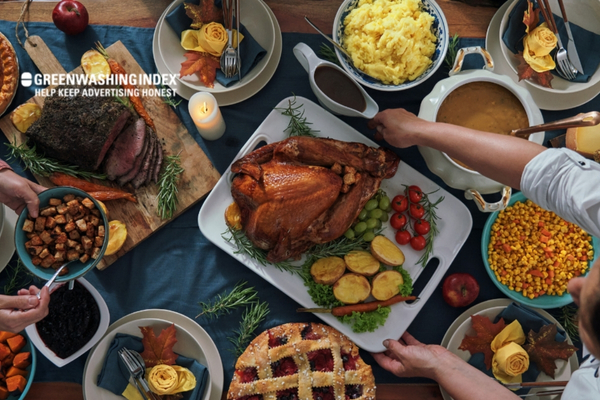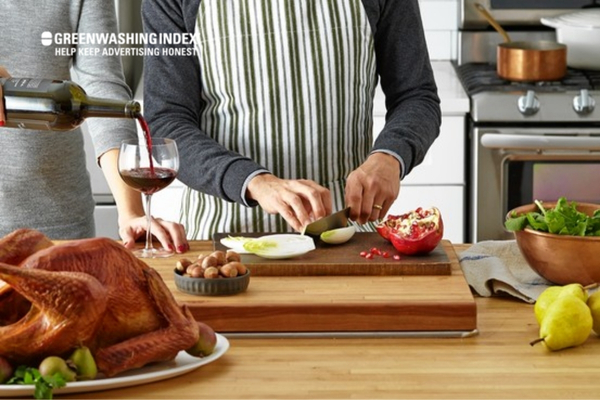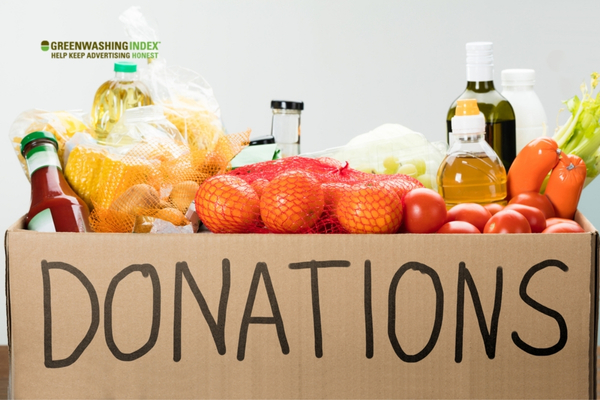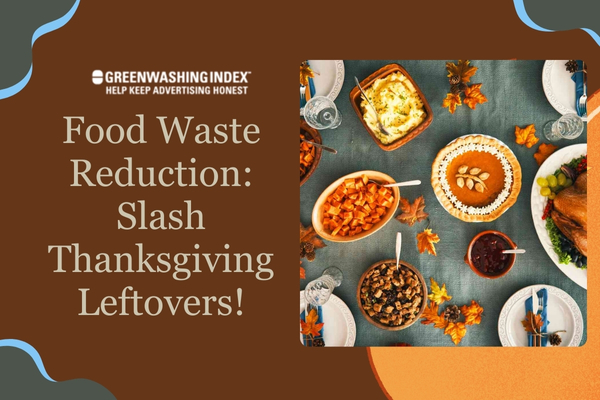Do you ever find yourself tossing out heaps of uneaten turkey and sides the day after Thanksgiving? If yes, then this little guide is just what you need. Imagine turning your holiday feast into a victory for the planet. That’s right—it’s time to tackle food waste reduction head-on during our beloved turkey day, and I’m here to tell you just how. Get ready to transform your Thanksgiving from wasteful to wonderful with some simple yet effective tweaks.
Reducing food waste during Thanksgiving isn’t just kind for your wallet; it speaks volumes about caring for our world. To start with, scope out what everyone likes before prepping that massive meal—it’s all about cooking smartly!
Use every last carrot and turn leftover pumpkin pie into tomorrow’s tasty treat. Be the hero who shows up without excess bags of wilted salad nobody asked for; instead, bring along precise portions and enjoy a feast where nothing goes to waste.
Planning Your Thanksgiving Feast
Thanksgiving is a time for family, friends, and of course, feasting. But with all the good times, there’s also a chance we end up with too much food on our hands. That can lead to waste, and nobody wants that. So let’s dive into how to plan your meal with food waste reduction in mind.

Understand Your Guests’ Preferences
Knowing what everyone likes to eat is key when you’re hosting Thanksgiving dinner. Why? Well, if you cook dishes that your guests don’t like, they probably won’t eat them. And if they don’t eat them, that food ends up in the trash.
So here’s what you can do:
- Talk to your guests before you start planning the menu. Ask them about their favorite Thanksgiving dishes and make a note of any dietary restrictions.
- Think carefully about everyone‘s tastes. You want each person at the table to see something they can’t wait to load onto their plate.
- If some folks are veggie-lovers while others are all about the turkey, plan portions so that nothing goes uneaten.
- Don’t forget about the sides! Sometimes side dishes can be big hits or misses. Get a sense of which ones your guests actually enjoy.
By getting this info early on, you’ll have an easier time making just enough for everyone – no more and no less – cutting down on leftovers and saving those perfectly good holiday foods from going to waste.
The Right Portion Sizes for a Memorable Meal – Food Waste Reduction
Portion control isn’t just about eating healthy; it’s also super important for reducing food waste during Thanksgiving meals. Too much food on the table means too much food possibly ending up in the garbage once everyone’s full.
Here are some tips on nailing those portion sizes:
- Figure out how many people you’re cooking for – simple counts matter.
- Use guidelines like:
- Turkey: Plan for 1 pound per person (so 10 pounds for 10 people). This could be less if your crowd leans towards smaller appetites or there are lots of kiddos running around.
- Sides: About 1/2 cup per person should do the trick – think stuffing or mashed potatoes here!
- Veggies: For veggies like green beans or carrots aim for about 1/4 cup per person.
- Desserts: Go for one small slice of pie or cake per guest because let’s face it: by dessert time most tummies are pretty stuffed!
Remember these numbers as starting points though! You know your group best – tweak as needed!
These thoughtful steps will help ensure that every last bite has its place: in bellies rather than bins! By sticking close to these suggestions, not only will there be less waste but also fewer hours spent fussing over unnecessary extra cooking leaving more time to enjoy this eco-friendly feast!
Also Read: Food Waste Reduction: Simple Tips for Major Impact
Smart Shopping for Thanksgiving
When it comes to prepping for a big Thanksgiving celebration, most of us think about all the good food and company. But I’m here to share a little secret with you – smart shopping can make your holiday even better! Not only will it help you save money, but you’ll also join the fight against food waste. So let’s talk about how we can do this with some simple yet effective steps.

Creating an Ingredient Checklist
Firstly, we’ve got to chat about making a shopping list. You might wonder why it’s such a big deal. It turns out that having a detailed checklist is like having a road map for buying just what we need and nothing more. When I stick to my list, there’s less chance I’ll end up with extras that go bad before they can be enjoyed.
Here’s what I do:
- Before stepping out, I sit down and think about the dishes I plan to make.
- For each dish, I write down every single ingredient needed – right down from salt to herbs.
- Then – and here’s the trick – I check my kitchen pantry and cross off anything I already have.
- What’s left becomes my shopping list.
This way, my ingredient checklist matches my cooking plan like two peas in a pod. And because every bit of food has its place on my Thanksgiving table or in specific recipes afterward, very little goes to waste.
Buying From Bulk Bins & Farmers Markets
Now let’s move on to where we shop! Ever thought about how much good we could do by picking where we buy our Thanksgiving ingredients? Buying from bulk bins and local farmers markets is not just trendy; it makes sense for our wallets and our planet.
When I swing by bulk bins at grocery stores:
- I measure: This means that instead of buying pre-packaged goods that might be too much or too little, I get exactly what’s needed.
- Less packaging: There’s no need for all those boxes and plastic bags which helps reduce trash.
At farmers markets:
- The produce couldn’t be fresher if it tried – which means it lasts longer before going bad!
- Speaking with farmers directly gives me insight into how much food they recommend for the number of people eating.
I love this approach because it feels personal. Plus, supporting local producers feels right; their fruits and veggies didn’t travel halfway across the globe using up fuel. If everyone bought just enough fresh produce for their celebrations rather than overstocking “just in case,” imagine how much less would end up being thrown away!
Smart shopping is something anyone can try out this Thanksgiving. Doing things like creating an ingredient checklist aligns well with our goals for food waste reduction during holidays like these! This strategy paired with choosing where you buy from sets you up for sustainable celebrations with minimal leftovers needing cooking tips later on.
Also Read: New Nordic Diet Guide: Embracing Health and Sustainability
Preparing Thanksgiving Dishes
When we gather with our loved ones for Thanksgiving, it’s a time to share good food and give thanks. But it’s also important to think about how we can make our feast in a way that doesn’t waste food. By being smart about how we cook our Thanksgiving dishes, we can enjoy a delicious meal and help our planet at the same time.

Mindful Cooking Techniques
Cooking with care doesn’t just make our food taste better; it can also play a big part in food waste reduction. I like to use some cooking techniques that help keep all the flavors while making sure I don’t throw away good food.
- Steaming Instead of Boiling: Steaming vegetables is a great way to cook them without losing too many nutrients or flavor in the water. This way, I’m not tempted to pour valuable taste down the drain. Plus, any leftover water from steaming is super tasty and full of vitamins – perfect for making soups!
- Roasting: Roasting can bring out natural sugars in foods like sweet potatoes and carrots which makes them taste sweeter without adding more ingredients. It also uses less oil or butter compared to frying.
- Baking on Parchment Paper: This tip is simple but works wonders! When I bake things like dinner rolls or pies on parchment paper, they don’t stick to the pan so there’s less chance of anything getting left behind or needing extra grease.
- Cooking in Batches: Sometimes when you cook a lot at once, not everything gets eaten and ends up in the trash. I avoid this by preparing dishes in smaller amounts based on how many people are coming over.
As I’m preparing for Thanksgiving, following these methods means my holiday feasting is more eco-friendly, because I’m reducing waste right from when I start cooking.
Making Use of Every Part of the Ingredients
I’ve come to see that almost everything has more uses than what meets the eye—especially when cooking this festive meal!
- Vegetable Peels: Instead of throwing away vegetable peels from potatoes or carrots, cleaning them well beforehand allows me to turn them into crispy snacks by roasting them with olive oil and salt. Or they can go into a stockpot along with other veggie scraps for making homemade broth.
- Turkey Bones: After we’ve enjoyed the turkey meat, those bones are still full of flavor! Boiling them along with some herbs makes rich turkey stock which is great as a base for soups or gravies.
By using these parts that are often thrown out, not only do we reduce waste but also create new tasty dishes and side options! By thinking ahead about using everything — from peelings to bones — my Thanksgiving becomes an example of sustainable celebrations.
As someone who loves both feasting and being kind to Earth, focusing on food waste reduction through careful preparation methods turns holiday leftovers into opportunities rather than something that needs to be tossed away. My approach ensures my celebrations are as eco-friendly as they are enjoyable.
Also Read: Mediterranean Diet: Your Heart and Earth-Friendly Guide
Saving Leftovers Creatively
Thanksgiving is a special time when I get together with family and friends, share what we’re grateful for, and enjoy a feast. Yet, every year after the big meal, I see lots of food left on my table. So, I’ve learned how to be clever about saving these goodies. It means less waste and more tasty meals for me later on!
Innovative Leftover Recipe Ideas
I like to think of leftovers as ingredients for new creations. Turning what I have into something different is fun and helps in food waste reduction.
For example:
- Turkey Sandwich: Now this isn’t just any sandwich. Take your turkey slices, add some cranberry sauce, stuff it between two slices of bread (maybe even the leftover dinner rolls!), and there you have a tasty lunch option.
- Pot Pie: Mix your veggies with chunks of turkey or ham in a pie crust. Pour in some gravy or cream soup as the sauce. Bake it until the crust turns golden.
- Frittata: Got eggs? Beat them and pour into a pan over your diced holiday meats and veggies. Cook slowly. It’s like an omelet but fancier!
- Soup: Boil turkey bones for stock. Toss in chopped-up leftovers like carrots or green beans – whatever you find! Add rice or noodles if you feel like it.
It’s not hard at all – just mix things up, cook safely, and enjoy your creations!
Proper Storage Tips for Extended Freshness
Storing food right helps us keep our leftovers fresh longer which means more yummy meals without waste.
Here’s what I do:
- Cool Down: Before stuffing everything in the fridge, let food cool down to room temperature.
- Air-Tight Containers: Put stuff into containers that don’t let air inside; this keeps things fresh.
- Labeling: Write down what’s inside each container plus the date I put them there so nothing’s forgotten.
- Fridge Organization: Put foods that spoil quickly where they’re easiest to see – usually on top shelves.
And here are some extra tools:
- Air-tight lids
- Freezer bags
- Labels/markers
- Good quality plastic wrap
These steps help me reduce food spoilage after Thanksgiving – making my celebration not only joyful but also eco-friendly!
Also Read: Maggots in Compost: Why They’re Actually Good!
Encouraging Food Donation & Composting
Thanksgiving is a time of abundance, and often, this abundance means we’re left with more food than we can eat. But I believe Thanksgiving should also be about giving and conscious living. That’s why it’s essential to think about food waste reduction in a way that benefits both people in need and the environment. Below are some ways to do just that.

Thanksgiving Spirit Through Sharing
When Thanksgiving ends and I’ve got more food than I can handle, I think it’s a great idea to spread the holiday cheer further by donating. Lots of places take unopened and uncooked foods, even prepared meals if they’re handled right. Here’s how I go about it:
- Check Local Food Banks: First thing, I look up local food banks or shelters in my area that accept food donations. They often have guidelines on what they can take.
- Community Centers: Sometimes community centers host post-Thanksgiving meals for those in need and are happy to take extra ingredients off your hands.
- Use Apps and Social Media: There are apps specifically designed for sharing surplus food with neighbors. Posting on a local social media group might find someone nearby who could use the extra food.
I make sure the food is safe to give away – no one wants to get sick from spoiled leftovers! And it feels good knowing someone else is getting joy from something I might have just thrown away.
Starting a Compost Bin at Home
Composting leftover scraps from Thanksgiving is a solid step toward food waste reduction. It’s like giving back to the earth! Starting isn’t as hard as some might think. Below are simple steps anyone can follow:
- Choose Your Bin: Find a bin that fits in your space – a small one if you live in an apartment, or maybe a larger one if you’ve got yard space.
- Know What Goes In: Stuff like veggie peels, fruit scraps, coffee grounds, eggshells, and leafy greens are perfect for composting. But cooked foods, especially meat or dairy products? Not so much; they don’t compost well.
- Layer Dry and Wet: Put dry leaves or paper between layers of kitchen waste (the wet stuff). This helps everything break down nicely.
- Turn It Over Every once in a while, give the compost pile or bin a good mix with a shovel or fork. This helps air get around and speeds up the process.
- Patience Is Key: Compost doesn’t happen overnight; it takes time to turn into that rich soil supplement we gardeners love.
By starting with these basic steps towards sustainable celebrations through composting this Thanksgiving, massive amounts of would-be waste could be turned into something useful for gardens all over!
Conclusion
As Thanksgiving draws near, many of us get ready for a day filled with joy, family, and lots of food. But in the excitement, it’s easy to forget about the impact our feast might have on the planet. Food waste reduction is not just good for the environment, it’s also kind to our wallets.
By planning effectively, shopping smartly, cooking mindfully, storing leftovers properly, sharing our bounty with others, and even starting a compost bin at home we can have an eco-friendly Thanksgiving that is just as festive and more sustainable.



